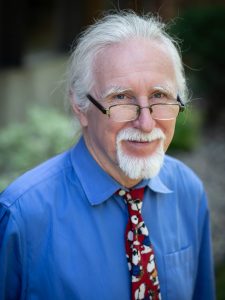 By Bob Hulteen
By Bob Hulteen
Social location makes such a difference, … even in the church, it seems.
Having grown up from fifth grade on in a North Dakota ALC congregation, I had never heard the names of Richard Allen or Absalom Jones. Neither school nor church provided information about these two faith leaders from the Revolutionary War Era.
But, I hadn’t lived in D.C., and attended an LCA congregation, for two weeks before the names of Allen and Jones were included in educational events or the intercessory prayers of the people. These two were discussed as essential church leaders, perhaps with some weak ties to Lutherans of the time (though I have trouble finding those connections).
With their courage to resist attempts to make these former slaves sit segregated in the balcony at St. George Methodist Church in Philadelphia, Jones and Allen led a walk out of that congregation. They started the Free African Society , which served as a precursor to the founding of the first African Methodist Episcopal Church (AME) by the Rev. Richard Allen, who had formerly been a deacon in the Methodist Church, … even when being ushered to the balcony.
Absalom Jones went on to be ordained in the Episcopal Church, pastoring the African Episcopal Church of St. Thomas in Phillie in the very late 1700s. (The keynote speaker for the 2023 Bishop’s Theological Conference, Dr. Catherine Meeks, is the executive director of the Absalom Jones Center for Racial Healing in Atlanta.)
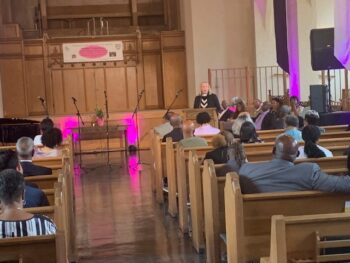
Pastor Ingrid Rasmussen expresses appreciation for the relationship with St. James AME.
LAST SATURDAY I joined 15 members of my congregation to celebrate the 160th anniversary of Mother Saint James AME’s ministry in the city of Minneapolis. Having existed in several locations throughout the city (often moving due to “expansions” in transit, including the development of the interstate highway system), St. James is now located in the Longfellow neighborhood of Minneapolis, just a few blocks from Holy Trinity Lutheran Church.
Pastor Ingrid Rasmussen of Holy Trinity was invited to share a message during the anniversary commemoration. She shared the joy of shared breakfasts with the Rev. Marchelle Hallman, a recent pastor at St. James. This relationship led to shared events between the congregations, including a merging of the choirs for a couple joint worship services and a shared congregational book study. Pastor Ingrid reflected on the many blessings that grew from the seed of those Denny’s breakfasts.
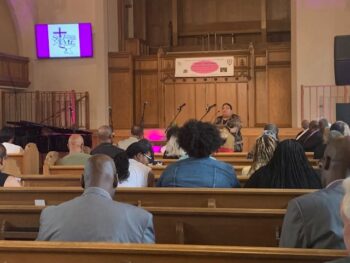
Presiding Elder Stacey Smith shares her gratitude for the ministry of Mother St. James AME.
Presiding Elder Stacey Smith, the chief executive of the Minneapolis-St. Paul District of the Fourth Episcopal District of the AME, during the celebratory program thanked God for the faithful witness of the Mother St. James congregation. Elder Smith governs a district that includes Minnesota, much of Iowa, and some congregations in Canada. Minneapolis Area Synod staff have had the honor of participating in a couple of the assemblies for this district, held here in Twin Cities, talking about environmental concerns and shared futures.
“Mother St. James AME has been a cornerstone of the African-American community, providing ‘hope during this challenging era.’”
St. James was founded in 1863. Think of that. While the Civil War raged, a faithful group of African American leaders started a church in what is now downtown Minneapolis, originally in the homes of Paul Brown and other free men and women of African descent. It has been a cornerstone of the African-American community, providing “hope during this challenging era,” as the celebratory program explains.
Seemingly every era has been “challenging” for the AME church in Minnesota. A few weeks earlier, community historian Greg McMoore of St. Peter AME, Minneapolis, shared data about how the Black community was divided with the construction of I-35, increasing the challenge to support African-American-owned businesses in South Minneapolis. He also shared about the burning down of an AME congregation in Hastings, with evidence that it was at the hands of nationalist groups.
Still, Mother St. James and other AME congregations persisted.
RECENT TRAGEDIES STRIKE too close to home for us as Lutherans. In 2015 Dylann Roof was welcomed into a Bible study at Mother Emanuel AME Church in Charleston, South Carolina. Twenty-one-year-old Roof opened fire during a closing prayer, killing nine members of the congregation that had offered him hospitality. Murdered were the Rev. Clementa C. Pinckney, Cynthia Marie Graham Hurd, Susie Jackson, Ethel Lee Lance, DePayne Middleton-Doctor, Tywanza Sanders, the Rev. Daniel Lee Simmons, Sharonda Coleman-Singleton, and Myra Thompson. (Pinckney and Simmons were graduates of the Lutheran Theological Southern Seminary.)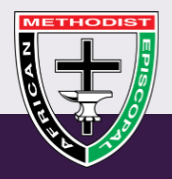
Dylann Roof had been confirmed a few years earlier in an ELCA congregation.
Somehow, Roof had gone through theological education in a Lutheran church and still felt that starting a race war was acceptable behavior. In other words, he had gone through years of confirmation and was still okay murdering people on account of their race, … in a church. While many might disagree, I think we all have to own that.
“While many might disagree, I think we all have to own that.”
Following a resolution passed at the 2019 Churchwide Assembly, congregations of the ELCA are encouraged to observe June 17 as the Commemoration of the Emanuel 9. It is a time for confession, lament, and commitment to change. The Churchwide staff has prepared resources to help congregations with worship planning. The horrific tragedy of Mother Emanuel and the rise of Christian nationalism in congregations near and far calls us to take a hard look at whether our faith practices are adequate to prepare us to resist this growing threat.
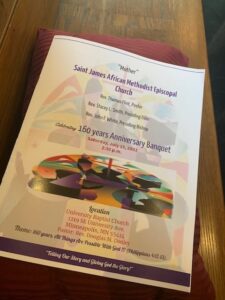
160th Anniversary Program
The ELCA already has full communion partnerships with six denominations, as well as ongoing bi-lateral conversations with six other denominations, including the AME. This relationship in this age seems to be especially important. So often institutions talk about wanting to diversify themselves. Just as often, it seems, this means inviting individuals into the already-existing culture of the institution.
A bi-lateral relationship with an existing denomination that has its own history and culture allows people to engage in conversation with relatively similar amounts of power. Each body can bring its own cultural assumptions to the table, looking for shared commitments and perspectives. And, there are many between the ELCA and AME.
Might this be a time for the natural development of healthy relationships that offer the opportunity to live into the calling of being the Body of Christ, existing for the sake of the world?
